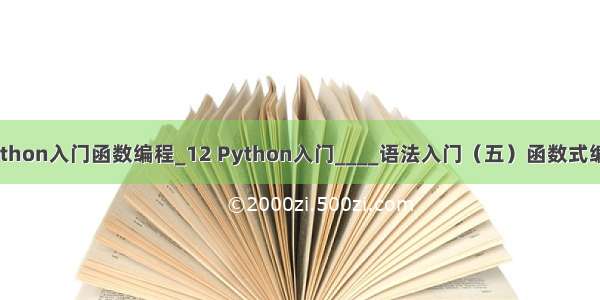
本文主要向大家介绍了Python语言之Pyhton入门笔记函数式编程,通过具体的内容向大家展示,希望对大家学习Python语言有所帮助。
一,匿名函数
def add(x,y)
return x+y
print(add(2,3))
f=lambda x,y:x+y #匿名函数需要lambdb来指定,lambda后直接跟参数,然后是:冒号,冒号后是表达式,只能是中表达式。当要引用匿名函数的时候,要赋值给变量才可以。
print(f(1,2))
二, 三元表达式
条件为真时返回的结果 if 条件判断 else 条件为假时返回的结果
x if x>y else y
例
x=2
y=1
f=x if x>y else y #因为是表达式,所以要被赋值使用。
print(r)
三,map的使用
list_x=[1,2,3,4,5,6]
def square(x):
reture x*x
r=map(square,list_x)
print(list(r))
四,map与lambda相结合使用
list_x=[1,2,3,4,5,6]
r=map(lambda x:x*x,list_x)
print(list(r)) #例三与例四相同
五,map与lambda相结合,多参数
list_x=[1,2,3,4,5,6]
list_y=[1,2,3,4,5,6]
r=map(lambda x,y:x*x+y,list_x,list_y)
print(list(r))
六,编程模型map/reduce 映射 归约
from functools import reduce
list_x[1,2,3,4,5,6]
r=reduce(lambda x,y:x+y,list_x,10) #reduce为连续计算,连续调用lambda.10参数可以忽略。如果忽略计算方式为,第一次,x=1,y=2,相加算计为3,第二次x=3,y=3,相加为6。第三次x=6,y=4相加为10,第四次,,,,,以次相加计算,一至加到6。当10不忽略的时候,10为x的初始值,第一次为x=10,y=1相加,以次计算......
print(r)
注:reduce()函数内做为参数的函数lambda()必须要有两个参数。
七,过滤,filter
list_x=[1,2,3,4,5,6]
r=filter(lambda x:True if x==1 else False,list_x) #函数filter()要求lambda一定要返回一个真假,或者返回一个能代表真假的,此名也可写为:r=filter(lambda x:x,list_x),因为x为1是真,为0是假
print(list(r))
八,装饰器
8.1)装饰器前奏
要求在每个函数前都要打印出时间
import Time
def f1():
print('This is a function')
def f2():
print('This is a function')
def print_current_time(fuc):
print(time.time())
fuc()
print_current_time(f1)
print_current_time(f2)
8.2)装饰器前奏
import time
def decorator(fuc):
def wrpper():
print(time.time())
fuc()
return wrpper
def f1():
print('This is a function')
def f2():
print('This is a function')
f=decorator(f1)
f()
8.3)装饰器
import time
def decorator():
def wrapper():
print(time.time())
fuc()
return wrapper
@decorator #装饰器 语法堂
def f1():
print('This is a function')
f1()
8.4)装饰器,参数
import time
def decorator():
def wrapper(func_name):
print(time.time())
fuc(func_name)
return wrapper
@decorator #装饰器 语法堂
def f1(func_name):
print('This is a function'+func_name)
f1()
8.5)装饰器,多参数
import time
def decorator():
def wrapper(*args): #可变参数,args可为任一变量
print(time.time())
fuc(*args)
return wrapper
@decorator #装饰器 语法堂
def f1(func_name):
print('This is a function'+func_name)
@decorator
def f2(func_name1,func_name2)
print('This is a function'+func_name1)
print('This is a function'+func_name2)
f1(test_func)
f2(test_func1,test_func2)
8.6装饰器,关键词参数
import time
def decorator():
def wrapper(*args,**kw): #可变参数,args可为任一变量 。关键词参数kw也是任一变量
print(time.time())
fuc(*args,**kw)
return wrapper
@decorator #装饰器 语法堂
def f1(func_name):
print('This is a function'+func_name)
@decorator
def f2(func_name1,func_name2)
print('This is a function'+func_name1)
print('This is a function'+func_name2)
@decorator
def f3(func_name1,func_name2,**kw) #**kw关键词参数
print('This is a function'+func_name1)
print('This is a function'+func_name2)
print(kw)
f1(test_func)
f2(test_func1,test_func2)
f3(test_func1,test_func2,a=1,b=2,c='1,2,3')
本文由职坐标整理并发布,希望对同学们学习Python有所帮助,更多内容请关注职坐标编程语言Python频道!
















